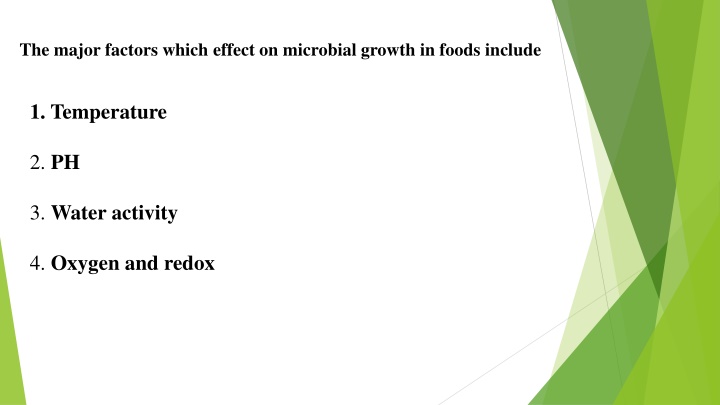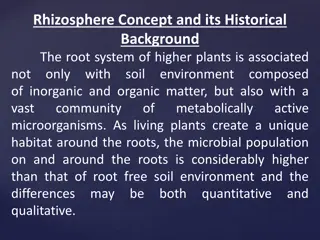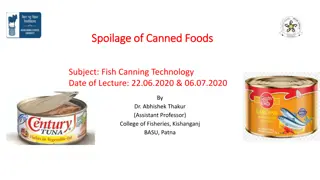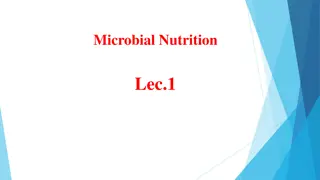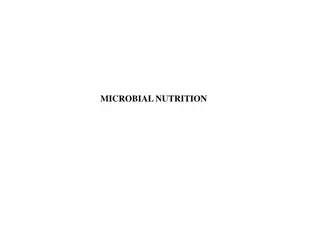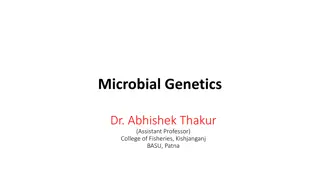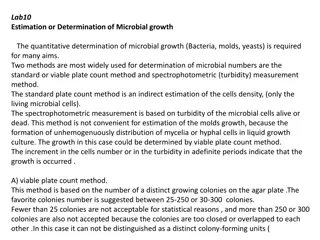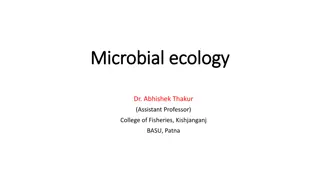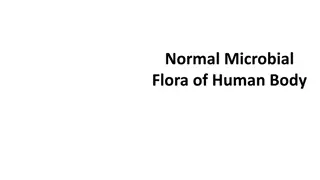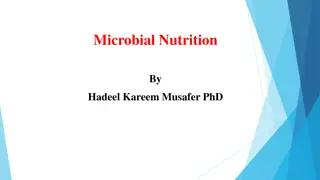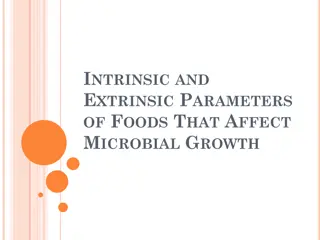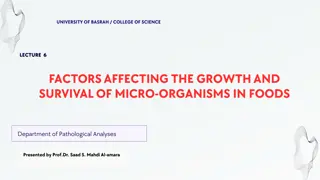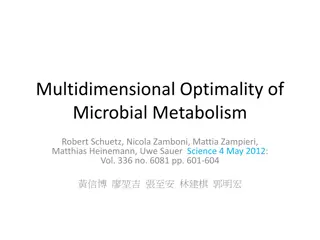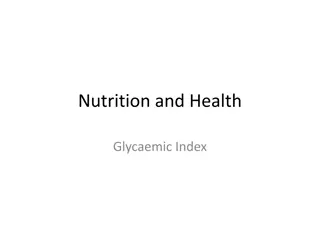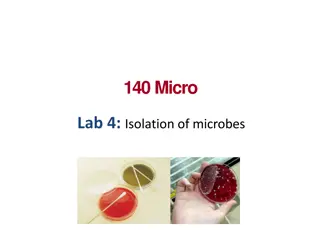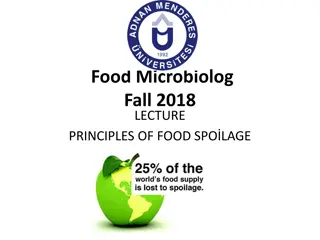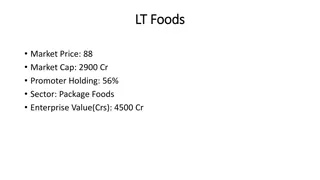Factors Influencing Microbial Growth in Foods
Understanding the impact of temperature, pH, water activity, and oxygen/redox levels on microbial proliferation in food products is crucial for ensuring food safety. Factors such as temperature and pH play a significant role in determining the growth rate of microorganisms, while water activity and oxygen levels can also influence the overall microbial community in food. Balancing these factors is essential in food preservation and storage to prevent spoilage and ensure the quality and safety of consumables.
Download Presentation

Please find below an Image/Link to download the presentation.
The content on the website is provided AS IS for your information and personal use only. It may not be sold, licensed, or shared on other websites without obtaining consent from the author.If you encounter any issues during the download, it is possible that the publisher has removed the file from their server.
You are allowed to download the files provided on this website for personal or commercial use, subject to the condition that they are used lawfully. All files are the property of their respective owners.
The content on the website is provided AS IS for your information and personal use only. It may not be sold, licensed, or shared on other websites without obtaining consent from the author.
E N D
Presentation Transcript
The major factors which effect on microbial growth in foods include 1. Temperature 2. PH 3. Water activity 4. Oxygen and redox
1. Temperature Minimum Temperature The temperature below which no growth occurs. At temperature below the minimum the properties of cell membranes change so that they can no longer transport materials into the cell Optimum Temperature The temperature at which the microorganism grows at its faster rate. Maximum Temperature The temperature above which no growth occurs. At temperature above the maximum enzymes become denatured and cease to catalyze essential reactions . also these temperatures damage the proteins and lipids in the cell membranes which cease to function normally . Eventually membranes collapse and the cells breakdown (thermal lyses)
A = Minimum Temperature B= Optimum Temperature C= Maximum temperature Temperature Growth rate A+B+C are described as Cardinal Temperatures For example For E. coli The minimum = 8 oC The optimum= 37 oC The maximum= 47 oC B C A Temperature
GROUP MINIMUM OPTIMUM MAXIMUM Obligate psychrophiles -10 10-15 20 Psychrophiles -10 20-30 42 Mesophiles 5 28-43 52 Thermophiles 30 50-65 70 Extreme thermophiles 65 80-90 100
25 10 0 Growth Rate Temperature below minimum Time Effect of temperature on the lag phase and growth rate 1- growth rate decreases 2- the length of lag phase increases
Water activity ( aw) Is the amount of water available in a food for microbial growth. Water activity = V.P of a substance or solution/V.P. of water at the same temperature water activity of pure water= 1 10% sucrose at 0 oC = 0.994 water activity not water content determines the limit of available water for microbial growth. water in the liquid state is essential for the existence of all living organisms. Water can be tied up in various ways that make it impossible for the organisms to absorb water through the cell membrane . The various ways in which water can become unavailable for growth are :- 1- The water contains dissolved solutes as sugars or salts . 2- The water is crystallized as ice . 3- The water is present as water of crystallization or hydration . 4- The water is absorbed onto surfaces ( matrix effects ).
Effect of water activity :- 1- A slower growth rate. 2- Increases the length of lag phase. 3- Production of less cells when the stationary phase starts. 4- Cells die more rapidly during death phase.
Water activity and food preservations Preservation methods that involve lowering the water activity of foods are:- 1- addition of salts . 2- addition of sugars. 3- drying. 4- freeze drying. 5- Freezing. Control of spoilage by lowering the water activity. Fresh foods with high water activities are prone to rapid spoilage whereas those with water activities below 0.61 are microbiologically stable.
Control water activity, prevent microbial growth *Like all organisms, microorganisms rely on water for growth. They take up water by moving it across the cell membrane. *This water movement mechanism depends on a water activity gradient on water moving from a high water activity environment outside the cell to a lower water activity environment within the cell. *When water activity outside the cell becomes low enough, it causes osmotic stress: the cell cannot take up water and becomes dormant. *The microorganisms are not eliminated, they just become unable to grow enough to cause infection. *Different organisms cope with osmotic stress in different ways.
Foods can be divided into 4 groups based on water activity levels and the spoilage organisms that are likely to cause problems:- 1- Very High moisture foods ( aw 0.99-0.95) Fresh food or processed foods with little or no preservation . Fresh poultry , meat , fruit ,milk , egg , vegetables ,fruit juices , cheese, butter . These foods are spoiled by gram negative bacteria ,fast growing moulds and non-osmophilic yeasts. 2- High moisture foods ( aw 0.95-0.90 ) Foods preserved by some drying or the addition of sugar or salt. Bread , fermented chesses , salted butter , fermented sausages , bacon , Ham . These foods are spoiled by gram positive bacteria , moulds and yeasts .
3- Intermediate moisture foods ( aw 0.90-0.61) Foods preserved by intense drying and or the addition of large amount of sugar or salt. Matured cheese , fruit concentrates , dried fruits, dried fish, jams , cakes and rice. These foods are generally spoiled by yeasts , moulds , xerophilic moulds , osmophilic yeast and halophilic bacteria. 4- Low moisture foods ( aw below 0.61 ) Foods preserved by very intense drying . Choclate , dried soups, honey, flour, dried milk, dried vegetables, cereals, crackers, sugar , biscuits. These foods are microbiologically stable and will only spoil if allowed to take up water from a moist atmosphere.
Effect of PH on microbial growth All microorganisms have a PH range in which they can grow and an optimum PH at which they can grow best. Microorganisms Minimum PH Optimum PH Maximum PH 8-11 8-9 10-11 Bacteria Yeasts Moulds 4-4.5 2-2.5 1.8-2 6.8-7.2 4-4.5 3-3.5 Some exceptions Microorganisms Minimum PH 3.8 2.8 Optimum PH Maximum PH Lactoacillus spp. Acinetobacter spp. 5 3 7.2 4.3
The effects :- 1- growth rate decreases. 2- the maximum number of cells produced drops. 3- the length of lag phase increases. 4-the length of stationary phases shorten. 5- the death rate increases.
How a PH below the minimum influences the growth of an organism PH well below minimum Lag phase PH just below the minimum Log . No. PH well below minimum Cell death Time Effects :- 1- No lag phase 2- rapid cell death
PH and Food preservation Adjusting the PH of foods using organic acids is an important method of food preservations controlling the growth of both food poisoning and food spoilage bacteria. The PH of processed foods are often modified using organic acids such as lactic and citric acids . Control of food borne pathogens is particularly important . Foods with PH below 4 are normally considered safe in relation to the growth of pathogenic bacteria.
Effect of Oxygen and redox on microbial growth The response of microorganisms to oxygen :- 1- Obligate aerobes ( Pseudomonas spp.) 2- Obligate anaerobes ( Clostridium spp.) 3- Facultative anaerobes ( Escherchia coli) 4- Oxygen independent ( Lactoacillus spp.) 5- Microaerophilic ( Campylobacter spp.)
Oxidation Reduction and microbial growth (OR or Eh) Is a measure of whether a material has a tendency to gain electron (become reduced) or loss electrons (become oxidized ). Organism Redox range mV Activity in relation to oxygen Pseudomonas fluorescens +500 to +100 Obligate aerobes Staphylococcus aureus +180 to -230 Facultative anaerobes Proteus vulgaris +150 to -600 Facultative anaerobes Clostridium spp. -30 to -550 Obligate anaerobes Clostridium perfringens +216 to -230 Aero tolerant anaerobes
Growth of microorganisms in relation to redox potential and the redox of foods. Growth of microorganisms lowers the redox of an environment either :- 1-by using oxygen present. 2- by producing reducing substances . 3- by combination of the two When a micro flora consist of a mixed population with different redox requirements , one species may lower the redox and change the environment in favor of the another.
The actual redox of a food depend on a number of factors : 1- The oxygen concentration in the environment of food and its access to the food. 2- Density of the food structure which affects the ability of oxygen in the environment to penetrate. 3- concentration and types of reducing substances in the food that resist changes in redox towards the positive . 4- The way in which the food is processed. 5- The PH of the food. For every decrease in the PH the Eh increases by a + 58 mV.
Conditions of Foods and the redox * The surface of solid food in contact with the air will have a positive redox whereas the interior may be negative. Carcass meat Surface +200 mV interior -150 mV * Processing can radically alter the redox of a material 1- Mixing a food with air at any stage during processing can increase the redox. ( milk during milking and bottling processes) 2- Mincing meat increases the surface area/ volume ( minced beef +200 mV interior of carcass -150 to -200 mV) 3- Heating drives off oxygen and may increase the quantity of reducing substances in a food . ( canned foods meat - 150 mV). 4- Packaging may exclude oxygen and maintain a low redox inherent in the food or produced by microbial growth with a closed environment.
The growth of types of microorganisms in foods in relation to redox * The surface of foods in contact with the atmosphere will support the growth of obligate aerobes , facultative anaerobes or oxygen independent organisms. * Foods from which oxygen has been excluded or removed ( by heating) and foods with high reducing activity will support the growth of obligate anaerobes , facultative anaerobes and oxygen independent organisms . * Partial removal of oxygen may allow the growth of true microaerophiles. *Moulds generally grow on food surfaces in direct contact with atmosphere oxygen. ( exceptions Byssochlamys fulva (spoilage of canned fruits . Some Rhizopus spp. Will grow at low concentration of oxygen )
